Offshore Report
Deepwater sector's growth will remain steady through 2010
Motivated by a shortage of onshore prospects, high commodity prices and good demand growth, operators continue to invest in high-cost deepwater projects.
Steve Robertson and Georgie MacFarlan, Douglas-Westwood Ltd., Canterbury, England; and Dr. Michael Smith, Energyfiles Ltd., Bucks, England
The World Deepwater Market Forecast, recently published by energy analysts Douglas-Westwood, forecasts continued growth in the deepwater sector, with annual expenditures reaching over $20 billion by 2010. In this article, the authors present the key findings of the study in conjunction with related information from The World Offshore Drilling Spend Forecast and The World Oil and Gas Forecast, both published by Douglas-Westwood in association with Energyfiles.
INTO THE DEEP
The underlying driver for all offshore activity is growth in global energy demand. For the medium term, at least, this means demand for hydrocarbons (mostly oil and gas). Over the long term, the trend toward increasing energy consumption is clear. Annual global energy consumption has more than tripled over the past 50 years, driven mainly by demand growth in the developing economies (particularly China in the years 2000 to 2004). Since China began its recent phase of economic development in 1991, its oil consumption has grown at a rate that has eclipsed all other users. Over the period 2000 to 2004, Norway's oil consumption growth was 3.6%, and the US rate was 4.1% – China’s oil consumption grew by 31.4%.
Despite improvements in energy efficiency, population growth in the developing countries is expected to maintain an upward pressure on demand. The US Energy Information Administration (EIA) recently forecast that world oil consumption will grow to 115.4 million bpd by 2030, although oil supplies to meet this consumption are not likely to be available.
Deepwater E&P activity is driven by a variety of supply-side and demand-side factors, including:
- Growth in global energy demand
- The lack of new opportunities onshore, or in shallow waters that can meet this demand
- New technological advances that improve technical and economic feasibility of deepwater developments.
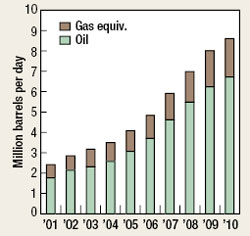 |
Fig. 1. Deepwater oil and gas production, 2001 – 2010. Source: The World Offshore Oil & Gas Forecast - Douglas-Westwood (Data © Energyfiles Ltd)
|
|
Deepwater oil and gas production is increasing rapidly, and output is expected to more than double over the period to 2010, Fig. 1. From 3 million bpd in 2005, deepwater oil production will grow to more than 6.7 million bpd in 2010, while deepwater gas output (currently modest but expanding rapidly) will increase to 108 Bcm (1.9 million boed) from 60 Bcm (1.0 million boed) over the same period.
To put this in context, deepwater oil output accounts for only 10% of total offshore oil production. Yet, over the next 10 years, its total share, relative to shallow-water output, will grow rapidly, to around 25% of offshore production by 2015, Fig. 2.
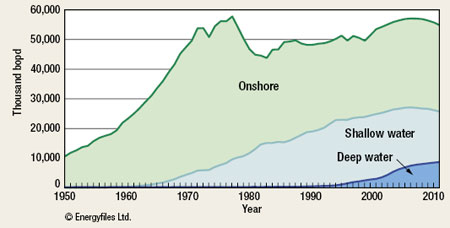 |
Fig. 2. Global oil production to 2015. Source: The World Offshore Oil & Gas Forecast - Douglas-Westwood (Data © Energyfiles Ltd).
|
|
DEEPWATER REGIONS
Africa is expected to be the leading deepwater development area over the 2006-2010 period, accounting for about 40% of global deepwater spending. Since the first brace of deepwater elephants – Shell's Bonga on the OPL 212 license off Nigeria and Total's Girassol on Block 17 off Angola, discovered in the spring of 1996 – Africa has emerged as perhaps the world's most significant deepwater region, with some stunning successes. The first floating production system to be installed in African deep waters was Total's Girassol project off Angola in 2001. This was followed by ExxonMobil's Xikomba in 2003, and then Kizomba A's TLP and FPSO.
A variety of deepwater development prospects are on-screen for the period to 2010, including ExxonMobil's Erha, Bosi and Akpo projects, Chevron's Agbami and Total's Usan/ Ukot. All of these are located off Nigeria. In Angolan waters, BP is moving ahead with its Greater Plutonio development in Block 18 and studying development options for the series of discoveries in Block 31. Total is developing its Rosa and Lirio finds via a subsea tieback to the Girassol FPSO.
With so much activity occurring off Nigeria and Angola, it is easy to overlook Egypt's emerging deepwater status. In the West Delta Deep Marine (WDDM) concession, BG has enjoyed some spectacular exploration successes. The Saffron/ Scarab development has subsequently established BG as one of the industry leaders in the adoption of subsea production technology. This development marked Egypt's first subsea completion, not to mention one of the world's longest subsea tiebacks. Further west, Apache has finalized a key sales agreement with the Egyptian government that will allow development of the Abu Sir, El Max, El King and Al Bahig discoveries to go ahead.
Latin America's deepwater activity is dominated by Brazil. National operator Petrobras has established itself as a pioneer in the use of innovative technology to achieve production from water depths in excess of 1,800 m. Over the period to 2010, the operator is expected to move into water depths exceeding 2,000 m. Petrobras will achieve yet more industry firsts, including the installation of Sevan Marine's unique Sevan Stabilized Platform (SSP) cylindrical monohull design FPSO on Piranema field. Elsewhere, the operator will continue with development of Roncador, Marlim Leste, Marim Sul and Albacora Leste fields, while perusing new finds, such as Golfinho. Overall, the region is expected to account for 20% of deepwater development capex over the 2006 – 2010 period.
With a few notable exceptions, deepwater fields in the US Gulf of Mexico tend to be fairly small, relative to those in other deepwater hotspots. The region's extensive offshore infrastructure, in the form of production platforms and export pipeline networks, and the relative proximity of service/ supply centers, has a significant influence on E&P activity. It turns otherwise marginal prospects into viable commercial propositions. These factors also mean that project lead times tend to be shorter than in other regions.
In addition, the use of subsea tiebacks to floating production systems has resulted in hub-and-spoke developments, allowing production from several small (otherwise uneconomic) fields to go ahead, produced via single floating production systems. Construction is underway on the Atwater Valley Producers' Independence Hub, a semisubmersible unit that will produce from Spiderman, Jubilee, Merganser, Vortex, San Jacinto, Atlas, Atlas NW, Cheyenne and Mondo fields in the DeSoto Canyon and Lloyd Ridge areas.
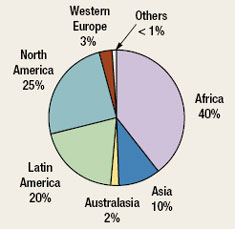 |
Fig. 3. Deepwater capex by region, 2006 – 2010. Source: The World Deepwater Market Forecast - Douglas-Westwood
|
|
A second hub to produce from other nearby fields is also planned. So, overall, North America should account for about 25% of deepwater development capex over the 2006-2010 period, Fig. 3.
The Golden Triangle of deep water – Africa, the Gulf of Mexico and Brazil – will still account for 85% of global deepwater spending over the forecast period. However, Asia's rapid emergence as a significant deepwater region should not be overlooked. Indonesia, Malaysia and India all have development prospects on-screen for the 2006 – 2010 period. Thus, the region should account for 10% of deepwater capex during this time.
DEEPWATER COMPONENTS
After the drilling and completion of subsea wells, an activity that is becoming increasingly expensive (in areas such as the US GOM) is floating platforms. They form the main component of deepwater development expenditure. Advances in technology, particularly in mooring systems and innovative hull designs, are allowing production from greater water depths, so as to be viable on both a technical and economic basis.
Over the next five years, about $28 billion is likely to be spent on deepwater floating production systems, plus $40 billion on drilling and completing subsea wells, and $14 billion on flowlines and control lines. In addition, subsea hardware and surface-completed wells could account for a further $10 billion, Fig. 4.
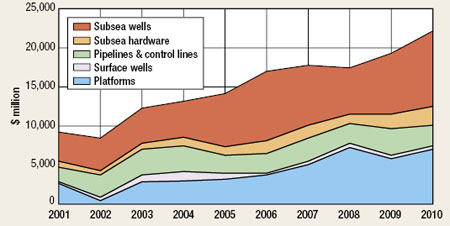 |
Fig. 4. Deepwater capex by component, 2006 – 2010.
|
|
The deepwater shopping list for the forecast period includes more than 1,300 subsea trees; 283 templates and manifolds; 71 platforms; and roughly 13,000 km of pipelines. Annual expenditure in the deepwater business is expected to reach $20 billion by 2010, with the overall expenditure for the 2006-2010 period totalling $94 billion.
DRILLING SUPPORTED BY DEEP WATERS
Due to lack of opportunity, exploratory drilling has declined since 1997, and this trend is forecast to continue through to 2010, albeit with a modest price-led resurgence in later years, Fig. 5. Even deepwater exploratory drilling, which grew rapidly up to 2001, has been relatively flat, due to a shortage of new areas to exploit. However, it is forecast to pick up in later years as ultra-deep waters become commercially more attractive.
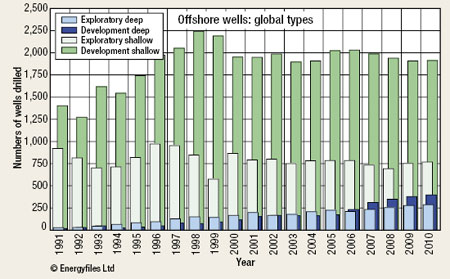 |
Fig. 5. Wells drilled to 2010. Source: The World Offshore Drilling Spend Forecast - Douglas-Westwood (Data © Energyfiles Ltd).
|
|
Offshore development drilling saw almost unbroken growth from 1991 to 1999 before beginning to decline, as new field development opportunities in many of the shallow-water areas of the world dwindled. With surging oil prices, shallow-water development drilling stabilized through to 2005, but further declines are now forecast. Meanwhile, total development drilling will be supported by rapid growth in deepwater drilling, especially in West Africa and the Gulf of Mexico.
Over the last five years, it is estimated that $160 billion were spent on shallow-water drilling, representing 83% of all drilling expenditures. Meanwhile, $33 billion were spent on deepwater drilling. Over the next five years, it is forecast that $197 billion will be spent on shallow-water drilling, while $65 billion will be spent on deepwater drilling.
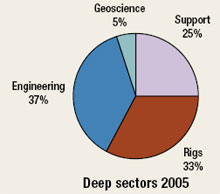 |
Fig. 6. Wells drilled to 2010. Source: The World Offshore Drilling Spend Forecast - Douglas-Westwood (Data © Energyfiles Ltd).
|
|
Within the deepwater sector, 37% of expenditures are directed toward engineering services, a quarter is earmarked for support, and 5% go toward geoscience. But it is surprising to many, that rigs only comprise 33% of total well costs, even in deep waters, Fig. 6.
Nevertheless, the increase in deep water relative to shallow water is substantial. While shallow waters are seeing increased expenditure – almost solely because of rising prices and rising unit well costs, especially after 2007 (Fig. 7) – deepwater expenditures reflect a real increase in activity. This is of global importance to the rig contractors and associated drilling service providers. From a mere 2% of global expenditures in 1991, almost all located in Brazil, the deepwater share increased to 19% by 2001 and is forecast to reach nearly 30% by 2010.
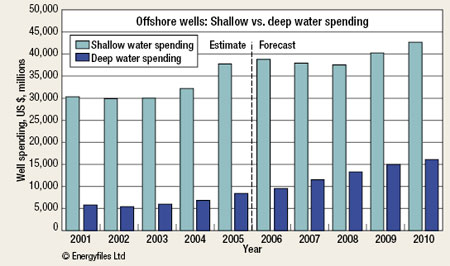 |
Fig. 7. Wells drilled to 2010. Source: The World Offshore Drilling Spend Forecast - Douglas-Westwood (Data © Energyfiles Ltd).
|
|
The relative shallow-water decline is driven by a global shortage of opportunities. There is no reason why the international oil industry, beyond the limited ambitions of national companies, would put capital into expensive, technologically demanding deepwater projects, if cheaper, conventional shallow-water developments could offer the same profitability. This is not a government-driven shortage resulting from poor investment terms. There are simply fewer and smaller, undiscovered or undeveloped, oil and gas fields in shallow waters.
Further information is available at www.dw-1.com. The authors can be contacted at admin@dw-1.com 
|
THE AUTHORS
|
 |
Steve Robertson manages Douglas-Westwood's oil and gas research activities and is lead author of the World Deepwater Market Forecast, the World Floating Production Report and the World LNG & GTL Report. Previously, he conducted research on the firm's projects for investment banks, and contributed to a number of other DWL studies, including The Subsea Processing Gamechanger Report, The World Offshore Drilling Report and The World Offshore Pipelines Report. Mr. Robertson holds a BSc degree in Computing and Economics. Prior to joining Douglas-Westwood, he worked in the defense and financial sectors. He is a member of the Energy Institute and the Society for Underwater Technology.
|
|
 |
Georgie MacFarlan is an analyst for Douglas-Westwood and manages the World Floating Production Database. She has also contributed to the World Floating Production Report, plus a number of the firm's studies for oil majors, government departments and investment banks. Ms. MacFarlan previously managed data systems for a major UK charity, as well as the Hampshire Constabulary, preparing performance indicator surveys for the Home Office. She holds a BSc degree in sociology.
|
|
 |
Dr. Michael R. Smith has spent more than 20 years working in the oil and gas industry. He has worked for several consultancies and oil companies as a geoscientist, and as exploration manager with responsibilities for ventures in the UK, Asia-Pacific, the Former Soviet Union, Yemen and Cuba. His main interests are now in regional energy supply and activity. He is chief executive of Energyfiles where he has developed a data and forecasting service available at www.energyfiles.com. His latest reports from Douglas-Westwood are The World Offshore Drilling Spend Forecast and The World Offshore Oil & Gas Forecast.
|
|
|












